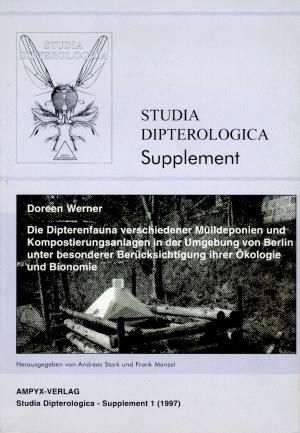 |
Suppl. 1 1997
Suppl. 2 1999
Suppl. 3 1998
Suppl. 4 1998
Suppl. 5 1998
Suppl. 6 1999
Suppl. 7 1999
Suppl. 8 2000
Suppl. 9 2000
Suppl. 10 2002
Suppl. 11 2002
Suppl. 12 2003
Suppl. 13 2005
Suppl. 14 2006
Suppl. 15 2008
Suppl. 16 2008
Suppl. 17 2008
Suppl. 18 2009
Compiled by:
Fritz Geller-Grimm
Contents:
Dr. Frank Menzel
Publishing date of supplement 1: September 1997
|
Doreen WERNER
Die Dipterenfauna verschiedener Mülldeponien und Kompostierungsanlagen in der Umgebung von Berlin unter besonderer Berücksichtigung ihner Ökologie und Bionomie. - [The dipterous fauna of various refuse dumps and composting facilities around Berlin, with special reference to its ecology and biology.] ISBN: 3-932795-00-8 Seiten/Pages: 176 Abstract:
Key words:
Zusammenfassung:
Anthropogen geprägte Lebensräume unterliegen in kurzen Zeiträumen starken Veränderungen. Dies gilt in besonderer Weise für Mülldeponien und Kompostierungsanlagen. Sie gehören zu den noch ungenügend untersuchten Biotopen. Auch aufgrund des verschwenderischen Umgangs mit Nahrungsmitteln ist eine kontinuierliche Erhöhung des Anteils organischer Abfälle auf vielen Deponien zu beobachten. Dies fördert wiederum die Bildung optimaler Brut- und Nahrungsplätze für zahlreiche, auch hygienisch bedeutsame, Tierarten. Einige von ihnen profitieren in besonderer Weise von den günstigen Temperatur-, Feuchtigkeits- und Nahrungsbedingungen und können zum massenhaften Auftreten neigen. Vor allem unter den Insekten, und hier insbesondere den Zweiflüglern (Diptera), finden sich viele Arten, die eine enge Bindung an menschliche Abfallplätze aufweisen und hier fast konkurrenzlos zur Entfaltung gelangen.
Stichwörter:
|
 Environments that are modified by human activities experience great changes within short periods of time. This is particularly true of refuse dumps and composting facilities, biotopes which have still not been adequately investigated. Our wasteful treatment of foodstuffs is resulting in a steady increase in the proportion of organic wastes in many dumps, and this in turn promotes the formation of ideal breeding and feeding sites for many species of animal, including those of hygienic importance. Some of them are able to take advantage of the favourable conditions of temperature, humidity and food-availability and develop huge populations. There are many species of insects, and especially of two-winged flies (Diptera), that are closely linked to human refuse sites and are able to develop there almost without competitors.
Environments that are modified by human activities experience great changes within short periods of time. This is particularly true of refuse dumps and composting facilities, biotopes which have still not been adequately investigated. Our wasteful treatment of foodstuffs is resulting in a steady increase in the proportion of organic wastes in many dumps, and this in turn promotes the formation of ideal breeding and feeding sites for many species of animal, including those of hygienic importance. Some of them are able to take advantage of the favourable conditions of temperature, humidity and food-availability and develop huge populations. There are many species of insects, and especially of two-winged flies (Diptera), that are closely linked to human refuse sites and are able to develop there almost without competitors.